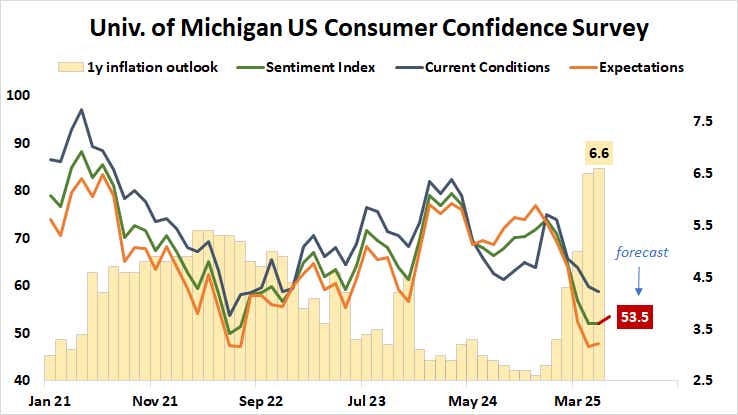US CPI Inflation and Consumer Confidence Data: Macro Week Ahead

US CPI Inflation and Consumer Confidence Data: Macro Week Ahead
By:Ilya Spivak
Will the markets start to care about US recession risk as the Fed continues to dither?
- Markets shrugged off breathless headlines as stocks and Treasury yields rose together.
- US inflation and consumer confidence data headline the economic calendar this week.
- Will traders care about recession risk as the Fed resists supporting gloomy consumers?
As the dust settled on another week of fiery headlines from Washington DC, a cautiously positive tone seemed to prevail across financial markets. Stocks finished the week on the upside, with the bellwether S&P 500 adding 1.5%. The tech-tilted Nasdaq 100 performed a touch better with a rise of 1.9%.
Bond yields rebounded across the Treasuries curve, with ten- and two-year rates rising 2.5% and 3.5% respectively. Cycle-sensitive crude oil prices surged, posting a 6.2% gain that brought them to a six-week high. A pro-growth message seemed to emanate from currency markets too as the euro rose while the Japanese yen fell against the US dollar.
US inflation set to rise, keeping the Fed in wait-and-see mode
The economic calendar will offer a clear opportunity to test this optimism in the week ahead. The critical question facing traders is likely to be whether the economy is strong enough to power ahead without support from the Federal Reserve as central bank officials go mum ahead of a policy conclave on June 18.
.png?format=pjpg&auto=webp&quality=50&width=759&disable=upscale)
First up, US consumer price index (CPI) data is expected to show that headline inflation accelerated to 2.5% year-on-year in May, up from 2.3% in the prior month. Perhaps most importantly, the core measure excluding volatile food and energy prices – the focus for Fed officials – is seen rising to 2.9%, the highest in three months.
Such a result seems likely to cement near-term inaction at the US central bank. Benchmark Fed Funds interest rate futures reveal that markets have firmly dismissed the possibility of a rate hike in June or July. At least one 25-basis-point (bps) is priced in by October. The probability of a second one before the end of the year stands at 60%.
Has US consumer confidence found a bottom?
Next, a preliminary look at this month’s consumer confidence survey from the University of Michigan is penciled in for a slight improvement after sentiment dropped to a three-year low in April and held there in May. The anchoring on display last month came as deepening pessimism about current conditions was offset by a modest uplift in expectations.

Consumption is the biggest driver of US economic growth, accounting for over 68% of gross domestic product (GDP). It was worryingly weak in the first quarter, posting the smallest contribution to overall output in nearly two years. Leading economic data, like April’s soggy retail sales and the ongoing rise in jobless claims, hint at ongoing weakness.
If sentiment is broadly downbeat, the markets will be left with an economy that appears to be inching toward recession and a central bank that is unwilling to be proactive in combating it. That hardly sounds supportive for stocks or the US dollar and seems primed to lift bonds and gold, but when traders are prepared to act like it remains unclear.
Ilya Spivak, tastylive head of global macro, has 15 years of experience in trading strategy, and he specializes in identifying thematic moves in currencies, commodities, interest rates and equities. He hosts #Macro Money and co-hosts Overtime, Monday-Thursday. @Ilyaspivak
For live daily programming, market news and commentary, visit #tastylive or the YouTube channels tastylive (for options traders), and tastyliveTrending for stocks, futures, forex & macro.
Trade with a better broker, open a tastytrade account today. tastylive, Inc. and tastytrade, Inc. are separate but affiliated companies.
Options involve risk and are not suitable for all investors. Please read Characteristics and Risks of Standardized Options before deciding to invest in options.
tastylive content is created, produced, and provided solely by tastylive, Inc. (“tastylive”) and is for informational and educational purposes only. It is not, nor is it intended to be, trading or investment advice or a recommendation that any security, futures contract, digital asset, other product, transaction, or investment strategy is suitable for any person. Trading securities, futures products, and digital assets involve risk and may result in a loss greater than the original amount invested. tastylive, through its content, financial programming or otherwise, does not provide investment or financial advice or make investment recommendations. Investment information provided may not be appropriate for all investors and is provided without respect to individual investor financial sophistication, financial situation, investing time horizon or risk tolerance. tastylive is not in the business of transacting securities trades, nor does it direct client commodity accounts or give commodity trading advice tailored to any particular client’s situation or investment objectives. Supporting documentation for any claims (including claims made on behalf of options programs), comparisons, statistics, or other technical data, if applicable, will be supplied upon request. tastylive is not a licensed financial adviser, registered investment adviser, or a registered broker-dealer. Options, futures, and futures options are not suitable for all investors. Prior to trading securities, options, futures, or futures options, please read the applicable risk disclosures, including, but not limited to, the Characteristics and Risks of Standardized Options Disclosure and the Futures and Exchange-Traded Options Risk Disclosure found on tastytrade.com/disclosures.
tastytrade, Inc. ("tastytrade”) is a registered broker-dealer and member of FINRA, NFA, and SIPC. tastytrade was previously known as tastyworks, Inc. (“tastyworks”). tastytrade offers self-directed brokerage accounts to its customers. tastytrade does not give financial or trading advice, nor does it make investment recommendations. You alone are responsible for making your investment and trading decisions and for evaluating the merits and risks associated with the use of tastytrade’s systems, services or products. tastytrade is a wholly-owned subsidiary of tastylive, Inc.
tastytrade has entered into a Marketing Agreement with tastylive (“Marketing Agent”) whereby tastytrade pays compensation to Marketing Agent to recommend tastytrade’s brokerage services. The existence of this Marketing Agreement should not be deemed as an endorsement or recommendation of Marketing Agent by tastytrade. tastytrade and Marketing Agent are separate entities with their own products and services. tastylive is the parent company of tastytrade.
tastyfx, LLC (“tastyfx”) is a Commodity Futures Trading Commission (“CFTC”) registered Retail Foreign Exchange Dealer (RFED) and Introducing Broker (IB) and Forex Dealer Member (FDM) of the National Futures Association (“NFA”) (NFA ID 0509630). Leveraged trading in foreign currency or off-exchange products on margin carries significant risk and may not be suitable for all investors. We advise you to carefully consider whether trading is appropriate for you based on your personal circumstances as you may lose more than you invest.
tastycrypto is provided solely by tasty Software Solutions, LLC. tasty Software Solutions, LLC is a separate but affiliate company of tastylive, Inc. Neither tastylive nor any of its affiliates are responsible for the products or services provided by tasty Software Solutions, LLC. Cryptocurrency trading is not suitable for all investors due to the number of risks involved. The value of any cryptocurrency, including digital assets pegged to fiat currency, commodities, or any other asset, may go to zero.
© copyright 2013 - 2025 tastylive, Inc. All Rights Reserved. Applicable portions of the Terms of Use on tastylive.com apply. Reproduction, adaptation, distribution, public display, exhibition for profit, or storage in any electronic storage media in whole or in part is prohibited under penalty of law, provided that you may download tastylive’s podcasts as necessary to view for personal use. tastylive was previously known as tastytrade, Inc. tastylive is a trademark/servicemark owned by tastylive, Inc.